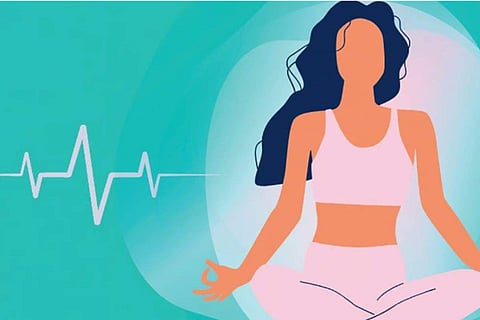
- LIFESTYLE
- FASHION
- FOOD
- ENTERTAINMENT
- EVENTS
- CULTURE
- VIDEOS
- WEB STORIES
- GALLERIES
- GADGETS
- CAR & BIKE
- SOCIETY
- TRAVEL
- NORTH EAST
- INDULGE CONNECT

Breathwork, often underestimated by those unfamiliar with its potential, offers a remarkable avenue for altering one’s physiological state simply by modifying the rhythm of inhalation and exhalation. While breathing is an involuntary process, deliberate techniques, such as moon breathing exemplifies the profound impact breathwork can have on mental well-being and sleep. This ancient Indian practice, known as chandra bhedana pranayama in Sanskrit, involves breathing through the left nostril.
Also read: Mistakes that are making your sinus worse
According to Manan Tripathi, a yoga teacher and breathwork coach from Delhi, moon breathing is grounded in the yogic philosophy that associates lunar energy with the left side of the body, offering
a pathway to slow down and steady oneself. “Moon breathing is not only a good technique to do if you’re feeling anxious but also if you are trying to get yourself to sleep and struggling with racing thoughts in your mind,” he says. This underscores the potential of breathwork to interrupt the stress-and-sleep-loss cycle often caused by nighttime anxiety.
The technique assists in controlling your breath, heart rate and nervous system. This enables you to experience a sense of calmness, relaxation and drowsiness without the burden of unread emails or the urgency to respond immediately. It provides a space for tranquillity, allowing you to alleviate stress and anxiety, freeing your mind from the pressure of impending board meetings.
Mumbai-based cardiologist Dr Sushant C Patil explains that moon breathing, like other sleep-focused breathing exercises, activates the parasympathetic nervous system, promoting relaxation by slowing the heart rate and reducing blood pressure. It diminishes the activity of the sympathetic nervous system, commonly associated with the ‘fight or flight’ response, paving the way for a calm state conducive to restorative sleep.
Recent research also supports the efficacy of moon breathing. A 2022 study found that left nostril breathing, a key component of moon breathing, increased brain activity associated with relaxation. Another study demonstrated that daily practice of left nostril breathing improved self-reported sleep quality in medical students over four weeks.
Also read: Tech getting in the way of your well being?
Delhi-based physician Sakshi Sharma emphasises that the soothing effects may stem from the reduction of air intake during the practice. By restricting airflow, practitioners can lower their respiratory rate, improving overall respiratory mechanics and avoiding the anxiety-triggering effects of hyperventilation. Additionally, single-nostril breathing helps retain carbon dioxide (CO2), enhancing circulation and positively influencing mental well-being.
The simplicity and accessibility of moon breathing make it a versatile tool for promoting relaxation. As Tripathi suggests, the practice can be seamlessly incorporated into daily life, requiring only a few minutes and no special equipment. The technique stands as a testament to the transformative power of breathwork, offering a natural and accessible method to alleviate anxiety, induce relaxation and foster restful sleep.
Here’s How to do it
1. Get into a comfortable position. Use your thumb to close your right nostril
2. Inhale through your left nostril
3. Choose one of the following options:
● Release your thumb from your right nostril and exhale through your nose or mouth
● Exhale through your left nostril
4. Repeat the process, maintaining a consistent and steady pace, ensuring that your inhales and exhales are of equal duration